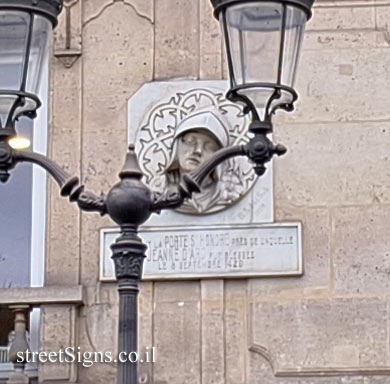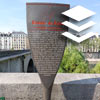One of the series of signs describing historical places in Paris. The signs were placed starting in 1992 and are also called sucettes Starck (Starck’s Lollipops) after Philippe Starck who designed them.
The sign describes the place where the Saint Honore gate stood, one of the gates of the city of Paris, which was used to enter the city from the west.
The place where the sign stands was photographed on the same day
 Click for a larger image
Click for a larger image The illustration in the center of the sign is shown here at magnification
 Click for a larger image
Click for a larger image On the house there is a plaque commemorating Joan of Arc whose injury is described on the current plaque
 Click for sign's details Translation of the text on the sign
Click for sign's details Translation of the text on the sign:
[An illustration of a ship, symbolizing the symbol of Paris]
History of Paris Porte Saint-Honoré Opened in 1380 in the enclosure of Charles V, the second Saint-Honoré gate formed a one-story square flanked at each corner by a round tower. Joan of Arc attempted an offensive there, on September 8, 1429, to retake Paris from the English. But her thigh was pierced by an arrow, while she was probing the ditch filled with water to fill it with fagots. On January 19, 1591, Henry IV sent soldiers disguised as millers to have the door opened under the pretext of supplying the besieged Parisians:
[Illustration of the porte]
the “flour day” was a failure, the Leaguers had walled up the gate. After the completion of the enclosure known as Louis XIll or the Fossés Jaunes, the Saint-Honoré gate, which had become useless, was demolished in 1636.

 Click for a larger image
Click for a larger image  Click for a larger image
Click for a larger image  Click for sign's details
Click for sign's details  Click for all signs belonging to The History of Paris (Starck's Lollipops)
Click for all signs belonging to The History of Paris (Starck's Lollipops)
 158 Meter |
158 Meter |  248 Meter |
248 Meter |  305 Meter |
305 Meter |  351 Meter |
351 Meter |  399 Meter
399 Meter